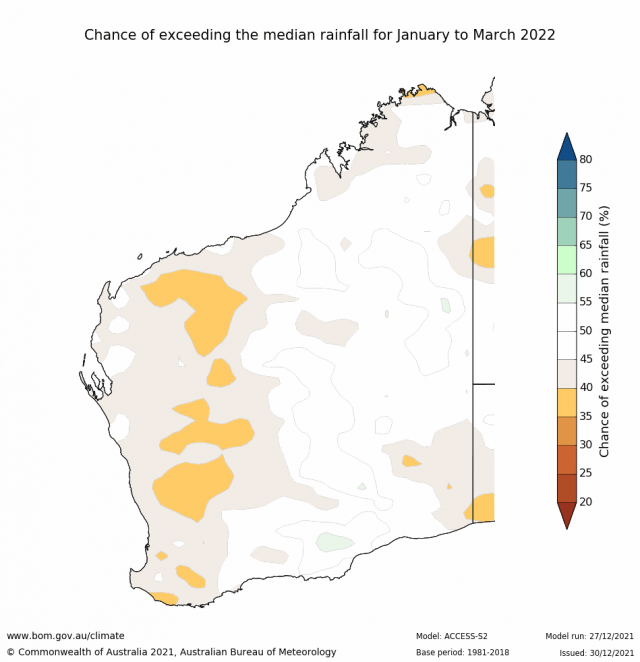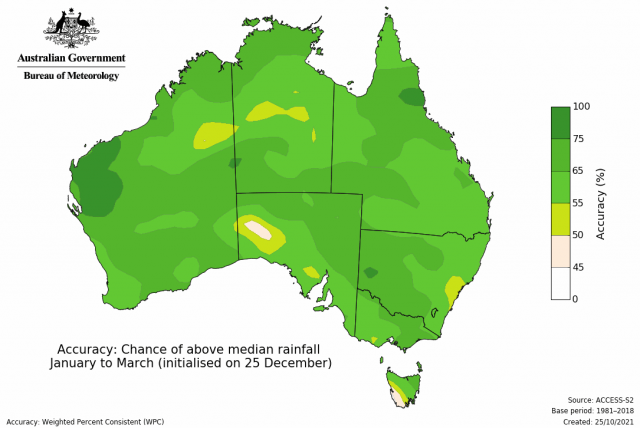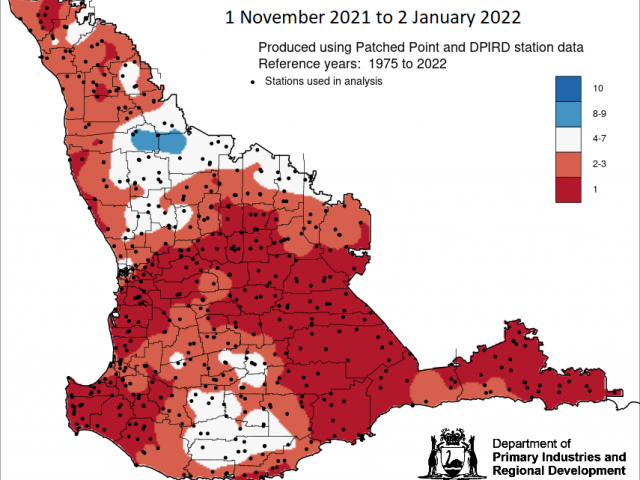Summary
The Department of Primary Industries and Regional Development’s (DPIRD) Statistical Seasonal Forecast (SSF) outlook for January to March 2022 is indicating less than 60% chance of exceeding median rainfall for the South West Land Division (SWLD).
- For January to March 2022, the SSF is indicating less than 60% chance of exceeding median rainfall for the SWLD. Less than 40% chance for parts of Central West, Central Wheatbelt, Great Southern and South East Coastal forecast districts. The most probable rainfall decile map indicates decile 4-7 for parts ofthe Lower West, South West, and South Coastal forecast districts, and decile 2-3 elsewhere. Predictive skill based on December conditions is mostly poor to good (50-75% consistent).
- The Bureau of Meteorology’s (BoM) seasonal outlook for January to March 2022 is indicating less than 45% chance of above median rainfall for the majority of the SWLD. For the South East Coastal forecast district, chances are wetter at 45-65%. Predictive skill is poor to good (55-75% consistent). The longer term outlook for February to April 2021 is mostly neutral, with wetter (up to 70%) chance for South East Coastal forecast district. Skill is poor to (45-55%).
- Temperature outlooks from BoM for January to March 2022 indicate a 45-80% chance of above average day-time maxima, with lower chances along the South Coast. Skill is 55-75%. There is a 60-80% chance of exceeding above average night-time minima for the SWLD. Skill is 55-75%.
- December rainfall was below average to average for the SWLD. December maximum temperatures were very much above average and minimum temperatures were average to above average.
- The main climate driver influencing the SWLD is the La Niña in the Pacific, which has little influence over rainfall in the SWLD. The Southern Annular Mode (SAM) remains positive but has no influence on SWLD climate in summer.
Three-month outlook for the south-west of Western Australia
Statistical Seasonal Forecasting (SSF)
To produce forecasts of rainfall for the coming months, DPIRD’s Statistical Seasonal Forecast (SSF) system uses historical relationships between global sea surface temperature and sea level pressure with rainfall in south-west Australia. Users can click on any station indicated on the map for location-specific forecast information from DPIRD’s Seasonal Climate Information pages.
For January to March 2022, the SSF is indicating less than 60% chance of exceeding median rainfall for the SWLD, and less than 40% chance for parts of the Central West, Central Wheatbelt, Great Southern and South East Coastal forecast districts. The most probable rainfall decile map indicates decile 4-7 for parts of the Lower West, South West, and South Coastal forecast districts, with decile 2-3 elsewhere. Predictive skill based on December conditions is mostly poor to good (50-75% consistent).
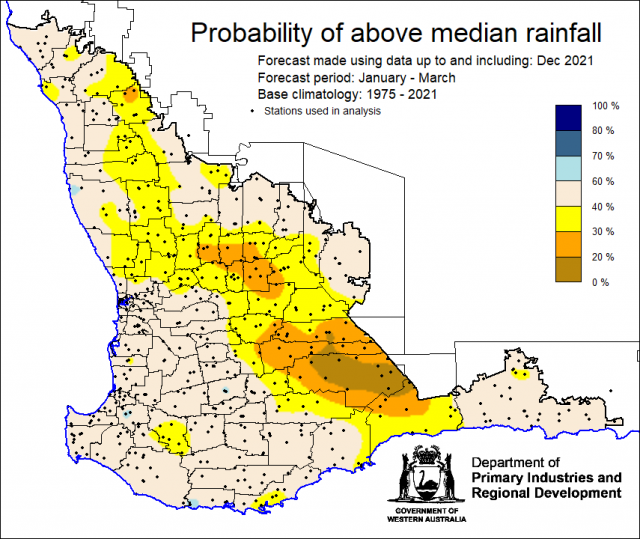
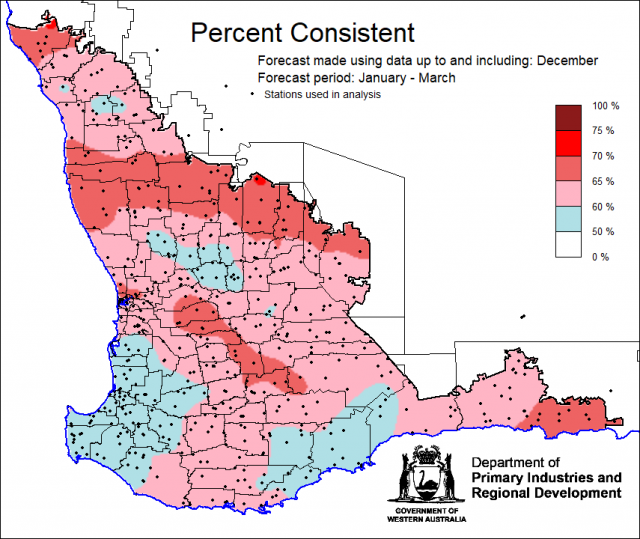
Bureau of Meteorology seasonal climate outlook
The Bureau of Meteorology's (BoM) climate forecast system for monthly and seasonal climate outlooks is the Australian Community Climate Earth-System Simulator – Seasonal (ACCESS–S2). It is a dynamical (physics-based) forecast modelling system, which is a collaboration between the Bureau of Meteorology and the UK Meteorological Office.
The Bureau of Meteorology’s seasonal outlook for January to March 2022 is indicating less than 45% chance of above median rainfall for the majority of the SWLD. For the South East Coastal forecast district, chances are wetter at 45-65%. Predictive skill is poor to good (55-75% consistent).
The longer term outlook for February to April 2021 is mostly neutral, with wetter (up to 70%) chance for South East Coastal forecast district. Skill is poor to (45-55%).
Temperature outlooks from the Bureau for January to March 2022 indicate a 45-80% chance of above average day-time maxima, and lower chances along the South Coast. Skill is 55-75%. There is a 60-80% chance of exceeding above average night-time minima for the SWLD. Skill is 55-75%.
The majority of other models are indicating neutral chances of exceeding median rainfall for the SWLD, for January to March 2022.
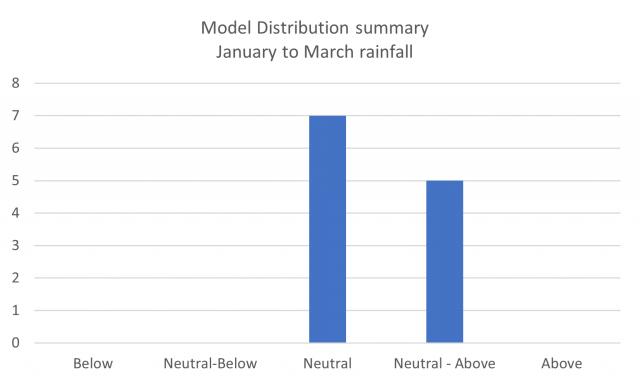
Recent climate
December rainfall was below average to average for the SWLD. December maximum temperatures were very much above average and minimum temperatures were average to above average. Rainfall since 1 November has been below decile 3 for much of the SWLD.
In December 2021, the atmospheric pressure was higher than normal over the SWLD.
In December 2021, the Indian Ocean sea surface temperatures north-west of Western Australia were warmer than normal.The January to March 2022 SST forecast, by the Bureau of Meteorology, indicates SSTs are likely to remain warmer than normal, north of WA.
The Southern Annular Mode (SAM), also known as the Antarctic Oscillation (AAO), describes the north–south movement of the westerly wind belt that circles Antarctica, dominating the middle to higher latitudes of the southern hemisphere. The SAM index is currently positive and is predicted to remain so until the end of January. In a positive SAM phase, the belt of westerly winds contracts towards Antarctica. A positive SAM phase in summer has no influence on SWLD rainfall. For more information, see the Bureau of Meteorology’s Climate Driver Update.
The Indian Ocean Dipole (IOD) is neutral. A neutral IOD has little influence on Australian climate.
The La Niña conditions continue in the tropical Pacific. Climate models suggest this La Niña will persist until the late southern hemisphere summer or early autumn, 2022. Based on past La Niña events, summer rainfall is expected to be average for the SWLD.
The table below summarises climate conditions of the past month and three-months for the SWLD, and can indicate what is likely to occur in the near future if climate conditions follow the current pattern.
| Climate indicator | Past month | Past 3 months |
|---|---|---|
| SWLD Rainfall | Below average | Average to above average |
| SWLD Mean Temperature | Above average | Below average to average |
| SWLD atmospheric pressure | Higher | Higher |
| Indian Ocean Sea surface temperature | Warmer | Warmer |
| El Niño/Southern Oscillation (ENSO) | La Niña | La Niña |
| Indian Ocean Dipole (IOD) | Neutral | Neutral |
| Southern Annular Mode (SAM) | Positive | Positive |

